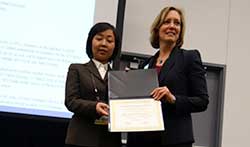Session Report: “Twentieth-Century Chinese Physicists and Physics”
By Danian Hu

Yuelin Zhu (seated) about to give his presentation, aided by session chair Danian Hu.
Sponsored by FHP and FIP, an invited session on “Twentieth-Century Chinese Physicists and Physics” was held at APS March meeting in Denver, CO on March 6, 2014. The session was organized and chaired by Dr. Danian Hu of The City College of New York. The session featured five invited speakers, three of whom came from Beijing, China. One of the three, Prof. Xiaodong Yin, was the recipient of a 2014 Beller Lecturership. During the session, Dr. Amy Flatten, the Director of International Affairs of APS, presented the Beller Lectureship certificate to Prof. Yin.
The first speaker in the session was Dr. Yuelin Zhu from Gutman Library, Harvard University. Zhu presented a paper titled “Chien-Shiung Wu: An Icon of Physicist and Woman Scientist in China,” which introduced relevant historical perspectives and show how Wu became an icon. Zhu analyzed especially the 1956 experiment of Cobalt-60 that Wu conceived and initiated. This one, and two other experiments carried out by others, eventually proved the presence of parity violation in weak interactions. Wu’s story, according to Zhu, may also help us understand the cultural characteristics of Chinese-born American physicists.

Prof. Xiaodong Yin receiving the 2014 Beller Lectureship Award from Amy Flatten, the APS Director of International Affairs.
Dr. Xiaodong Yin from Capital Normal University in Beijing was the second speaker. Her presentation, “Chinese Physicists Educated in the Great Britain during the First Half of the 20th Century,” examined the experiences of more than thirty Chinese students who went to study physics in Great Britain during the first decades of the last century. Comparing these British trained Chinese physicists with their counterparts educated in Japan and America, Yin argued that Chinese physicists educated in Britain had a high degree of specialization as a whole and formed a unique style, making unique contributions to Chinese physics development.
Prof. Tian Yu Cao of Boston University spoke next on “Mao and physics research in China in the 1950s-1960s: the H-bomb project and the Straton model.” Cao analyzed Mao’s deep and long-lasting impact on physics research in terms of (1) his establishment of an institutional infrastructure for modern physics research, (2) his science policy in which physics research was all organized in a mission-oriented way, and (3) his metaphysical presumption of infinite divisibility of matter, the guiding spirit of China’s only research project in fundamental particle physics, the so-called Straton model that was conceived and pursued in China from the mid-1960s to the early 1980s.
The fourth speaker was Prof. Bing Liu of Tsinghua University in Beijing. Liu’s presentation focused on “some problems in the competition of high-temperature superconductivity research during the late 1980s.” He investigated especially the competition among American, Japanese, and Chinese scientists during that period, and broached such issues such as different national styles in research strategy and methodology, peer review, the “Matthew Effect,” and trade secrets. All these issues, according to Liu, are not only historically significant but also sociologically and philosophically meaningful.
Finally, Dr. Jinyan Liu from The Institute for the History of Natural Sciences, Chinese Academy of Sciences (CAS), presented a brief history of the Chinese Institute of Theoretical Physics (ITP) in the CAS. Founded in June 1978, the ITP has played an important role in the Chinese development of theoretical physics, especially in organizing and undertaking major national projects, expanding international exchanges and cooperation, and nurturing advanced researchers. Liu’s presentation discussed the establishment and accomplishments of the ITP as well as its academic leaders in the past 35 years.
The articles in this issue represent the views of their authors and are not necessarily those of the Forum or APS.
